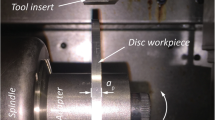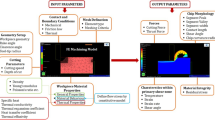Abstract
As a result of the development of new materials for high temperature applications the potential for mass reduction and increased process temperatures is constantly being expanded. Intermetallic γ-TiAl alloys can meet these demands to a large extent. The properties necessary for these applications have an adverse effect on the machinability however and render intermetallic titanium aluminides as difficult to machine materials. Cutting operations tend to produce damaged surfaces which are unsuitable for the intended applications. As the basis for a reliable and economic cutting technology, the chip formation of the intermetallic TiAl alloy TNBV5 has been examined in quasi-static cutting experiments. Observations showed that increased workpiece temperatures lead to a transition of the chip formation from segmented to continuous chips. By decreasing the undeformed chip thickness crack-free surfaces could be produced at low workpiece temperatures. In this case other mechanisms than the thermal activation of slip systems must be the reason for the observed large plastic deformations. The theory that hydrostatic pressure leads to this behavior is substantiated by the results of finite element simulations. This offers the possibility for damage free machining at lower cutting speeds, thus enabling the use of conventional tool materials at an acceptable tool life.







Similar content being viewed by others
References
Schubert F (2004) Heißes Eisen. In: Das Industriemagazin. 49:26–29
Appel F, Oehring M (2002) g-Titanaluminid-Legierungen: Legierungsentwicklung und Eigenschaften. In: Peters M, Leyens Ch (Hrsg): Titan und Titanlegierungen, Köln, pp 39–103
Knippscheer S, Frommeyer G (2000) Properties of low cost TiAl automotive valves produced by cold wall induction melting and permanent mold centrifugal casting. In: Titanium ′99, Proceedings of the 9th world conference on Titanium, St. Petersburg, Russia, pp 320–327
Smarsly W, Singheiser L (1994) Potential of intermetallics to replace superalloys for advanced operation conditions in gas turbines. In: Counsouradis D et al (eds) Materials for advanced power engineering, part II. Kluwer, pp 1731–1756
Appel F, Brossmann U, Christoph U, Eggert S, Janschek P, Lorenz U, Müllauer J, Oehring M, Paul DH (2000) Recent progress in development of gamma titanium aluminides. Adv Eng Mater 11:699–720
Appel F, Oehring M (2003) Entwicklung von TiAl-Legierungen der 3. Generation. In: Dietrich M (ed) Titan-Aluminid-Legierungen—Eine Werkstoffgruppe mit Zukunft, Jülich, pp 85–91
Kumpfert J, Leyens C (2002) Orthorhombische Titanaluminide: Schadenstolerante intermetallische Werkstoffe. In: Peters M, Leyens C (eds) Titan und Titanlegierungen, Köln, pp 105–137
Klocke F, Stegen A (2006) Dem spröden Stoff die Spanbildung beibringen. In: Werkstatt und Betrieb. 10:64–67
Uhlmann E, Herter S (2006) Studies on conventional cutting of intermetallic nickel and titanium aluminides. In: Proceedings of the Institution of Mechanical Engineers, Part B: Journal of Engineering Manufacture. 220(9), pp 1391–1398
Uhlmann E, Frommeyer G, Herter S, Knippscheer S, Lischka JM (2003) Studies on the conventional machining of TiAl based alloys. In: Lütjering G, Albrecht J (eds) Ti-2003 science and technology. Proceedings of the 10th world conference on titanium. 4:2293–2300
Herter S (2009) Spanbildung und Randzonenbeeinflussung beim Drehen intermetallischer Titanaluminide. Dissertation Technische Universität Berlin (in preparation)
Clos R, Lorenz H, Schreppel U, Veit P (2005) Verformungslokalisierung und Spanbildung in Inconel 718. In: Tönshoff HK, Hollmann F (eds) Hochgeschwindigkeitsspanen. Wiley, pp 426–445
Gente A (2002) Spanbildung von TiAl6V4 und Ck45N bei sehr hohen Schnittgeschwindigkeiten. Dissertation. Technische Universität Braunschweig
Clemens H, Kestler H (2000) Processing und applications of intermetallic γ-TiAl- based alloys. Adv Eng Mater 2(9):551–570
Knippscheer S (2007) Entwicklung und Charakterisierung von intermetallischen Leichtbaulegierungen auf Basis von TiAl-(Cu, Mo, Cr, Nb, Si). Dissertation, Universität Duisburg-Essen
Rommerskirchen M (1997) Struktur und Eigenschaften feinkristalliner γ-TiAl-Legierungen. Dissertation, RWTH Aachen
Westbrook JH, Fleischer RL (2000) Basic mechanical properties and lattice defects of intermetallic compounds. Wiley, London
Sparka UAH (1998) Verformungs- und Verfestigungsverhalten in ein- und zweiphasigen Titanaluminid-Legierungen. Dissertation, Universität Hamburg
Tönshoff HK, Denkena B (2004) Spanen Grundlagen. Springer, 2. Auflage
Tönshoff HK, Denkena B, Ben Amor R, Ostendorf A, Stein J, Hollmann C, Kuhlmann A (2005) Spanbildung und Temperaturen beim Spanen mit hohen Geschwindigkeiten. In: Tönshoff HK, Hollmann F (eds) Hochgeschwindigkeitsspanen. Wiley, pp 1–40
Kármán Th (1911) Festigkeitsversuche unter allseitigem Druck. In: Zeitschrift des Vereins Deutscher Ingenieure. 42(55):224–235
Tönshoff HK, Arendt C, Ben Amor R (2000) Cutting of hardened steel. Ann CIRP 49:547–566
Denkena B, Jivishov V (2005) Größeneinflüsse auf die Spanbildung, Zerspankräfte und Eigenspannungen beim Drehen—Experiment und Simulation. In: Vollertsen F (Hrsg) Prozessskalierung. Strahltechnik, vol 27, BIAS, Bremen, pp 285–298
Albrecht P (1960) New developments in the theory of the metal-cutting process—part I, the ploughing process in metal cutting. Trans ASME J Eng Industry 82:348–358
Acknowledgments
The authors gratefully acknowledge the financial support of the German Science Foundation (DFG). We would also like to thank the staff of the German High-Performance Computer Center North (HLRN) for the allocation of calculating time contingents and for the continuous presence as well as the support in the solution of problems.
Author information
Authors and Affiliations
Corresponding author
Rights and permissions
About this article
Cite this article
Uhlmann, E., Herter, S., Gerstenberger, R. et al. Quasi-static chip formation of intermetallic titanium aluminides. Prod. Eng. Res. Devel. 3, 261–270 (2009). https://doi.org/10.1007/s11740-009-0166-0
Received:
Accepted:
Published:
Issue Date:
DOI: https://doi.org/10.1007/s11740-009-0166-0




